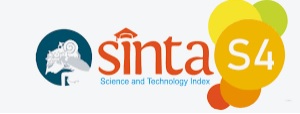Pengembangan Chatbot Informasi Pariwisata di Kabupaten Pati Menggunakan Metode Natural Language Processing Berbasis Dialogflow
Abstract
Pati Regency has several attractive tourism destinations. Increasing numbers of tourists have resulted in increased demand for information before or during travel. Tourist information staff may often get the same questions over and over and have limited time and resources to provide services around the clock. This problem can be overcome using a chatbot. Chatbots can handle these questions efficiently. Natural Language Processing (NLP) method was used in the development of the chatbot which was built using the Dialogflow framework. This method is able to make computers able to understand human language in the form of text. In testing using black-box testing the chatbot was able to answer 12 out of 13 test scenarios so that an accuracy of 92.3% was obtained and the results of User experience Questionnaire (UEQ) testing obtained an attractiveness value of 1.62, a Perspicuity value of 1.57, an efficiency value of 1.60, a Dependability value of 1.30, a stimulation value of 1.47, and a novelty value of 1.23.
Keywords: Chatbot; Dialogflow; Natural Language Processing; Tourism
Â
Abstrak
Kabupaten Pati memiliki beberapa destinasi pariwisata yang menarik. Peningkatan jumlah wisatawan berdampak pada meningkatnya permintaan informasi sebelum atau saat perjalanan. Staf informasi wisata mungkin sering mendapat pertanyaan yang sama berulang-ulang dan memiliki batasan waktu dan sumber daya untuk memberikan pelayanan sepanjang waktu. Permasalahan tersebut dapat diatasi menggunakan chatbot. Chatbot dapat menangani pertanyaan-pertanyaan tersebut dengan efisien. Metode Natural Language Processing (NLP) digunakan dalam pengembangan chatbot yang dibangun menggunakan framework Dialogflow. Metode ini mampu membuat komputer mampu mengerti bahasa manusia dalam bentuk teks. Dalam pengujian menggunakan black-box testing chatbot mampu menjawab 12 dari 13 skenario pengujian sehingga didpatkan akurasi sebesar 92.3% dan hasil pengujian User experience Questionnaire (UEQ) mendapatkan nilai daya tarik sebesar 1,62, nilai kejelasan sebesar 1,57, nilai efisiensi sebesar 1,60, nilai ketepatan sebesar 1,30, nilai stimulasi sebesar 1,47, dan nilai kebaruan sebesar 1,23.
Â
Keywords
References
P. F. Nuryananda and A. Q. Al Fitriani, “Permasalahan Kultural dan Pentingnya Kontekstualisasi dalam Penerapan Teknologi dalam Pengembangan Pariwisata Kampung Adat Segunung,†Khasanah Ilmu - J. Pariwisata Dan Budaya, vol. 14, no. 2, pp. 104–114, 2023, doi: 10.31294/khi.v14i2.15931.
K. Pradityo, “Sistem Chatbot Untuk Membantu Diagnosa Kerusakan Sistem Komputer,†J. Sains Teknol. Fak. Tek., vol. 2, pp. 1–10, 2015.
A. Muhidin, M. Danny, & E. Rilvani, "Algoritme Multinomial Naïve Bayes Pada Aplikasi Chatbot Layanan Informasi Berbasis Teks". Progresif: Jurnal Ilmiah Komputer, vol. 19, no. 1, pp. 71-80, 2023.
D. Khurana, A. Koli, K. Khatter, and S. Singh, “Natural language processing: state of the art, current trends and challenges,†Multimed. Tools Appl., vol. 82, no. 3, pp. 3713–3744, 2023, doi: 10.1007/s11042-022-13428-4.
S. A. Thorat and V. Jadhav, “A Review on Implementation Issues of Rule-based Chatbot Systems,†SSRN Electron. J., no. Icicc, pp. 1–6, 2020, doi: 10.2139/ssrn.3567047.
A. Y. Chandra, D. Kurniawan, and R. Musa, “Perancangan Chatbot Menggunakan Dialogflow Natural Language Processing (Studi Kasus: Sistem Pemesanan pada Coffee Shop),†J. Media Inform. Budidarma, vol. 4, no. 1, pp. 208–215, 2020, doi: 10.30865/mib.v4i1.1505.
S. Varitimiadis, K. Kotis, A. Skamagis, A. Tzortzakakis, G. Tsekouras, and D. Spiliotopoulos, “Towards implementing an AI chatbot platform for museums,†Int. Conf. Cult. Informatics, Commun. Media Stud., vol. 1, no. 1, pp. 0–15, 2020, doi: 10.12681/cicms.2732.
K. Tsitseklis, G. Stavropoulou, A. Zafeiropoulos, A. Thanou, and S. Papavassiliou, “RECBOT: Virtual Museum navigation through a Chatbot assistant and personalized Recommendations,†UMAP 2023 - Adjun. Proc. 31st ACM Conf. User Model. Adapt. Pers., pp. 388–396, 2023, doi: 10.1145/3563359.3596661.
H. T. Nguyen, T. T. Tran, P. T. Nham, N. Uyen, B. Nguyen, and A. D. Le, “AI Chatbot for Tourist Recommendations : A Case Study in Vietnam,†vol. 28, no. 2, pp. 232–244, 2023.
Mukrodin and N. M. Sasmita, “rtificial Inteligence Dalam Apilkasi Chatbot Sebagai Helpdesk Obyek Wisata Dengan Permodelan Natural Language Processing (Studi Kasus: Kabupaten Cilacap),†Smart Comp Jurnalnya Orang Pint. Komput., vol. 10, no. 1, pp. 7–14, 2021, doi: 10.30591/smartcomp.v10i1.2135.
K. P. Dharmawan, I. M. Sukarsa, and D. P. Githa, “Rancang Bangun Chatbot Desa Wisata Badung Bali dengan Dialogflow,†JITTER J. Ilm. Teknol. dan Komput., vol. 3, no. 2, pp. 1217–1226, 2022, doi: 10.24843/jtrti.2022.v03.i02.p20.
R. Alotaibi, A. Ali, H. Alharthi, and R. Almehamadi, “AI Chatbot for Tourism Recommendations A Case Study in the City of Jeddah, Saudi Arabia,†Int. J. Interact. Mob. Technol., vol. 14, no. 19, pp. 18–30, 2020, doi: 10.3991/ijim.v14i19.17201.
A. D. Ferdian and S. N. Anwar, “Pengembangan Chatbot untuk Informasi Wisata Interaktif di Tangerang Selatan menggunakan Framework Rasa,†vol. 5, no. 4, pp. 476–483, 2023.
M. A. Rohman and P. Subarkah, “Design and Build Chatbot Application for Tourism Object Information in Bengkulu City,†vol. 1, no. 1, pp. 28–34, 2024.
M. Solekhah, “Krepa : Kreativitas Pada Abdimas,†vol. 1, no. 2, pp. 1–17, 2023.
R. Mahendra and M. Kamayani, “Menerapkan Algoritma Neural Network Pada Chatbot Mengenai Pariwisata Di Provinsi Bangka Belitung,†vol. 7, no. 2, pp. 698–709, 2023.
T. J. Maulani and A. R. P. Suprapto, “Evaluasi User Experience Menggunakan Metode Usability Testing dan User Experience Questionnaire (UEQ)(Studi Kasus: Website Superprof. co. id dan Zonaprivat. com),†J. Pengemb. Teknol. Inf. dan Ilmu Komput. e-ISSN, vol. 5, no. 6, pp. 2639–2645, 2021.
How To Cite This :
Refbacks
- There are currently no refbacks.











